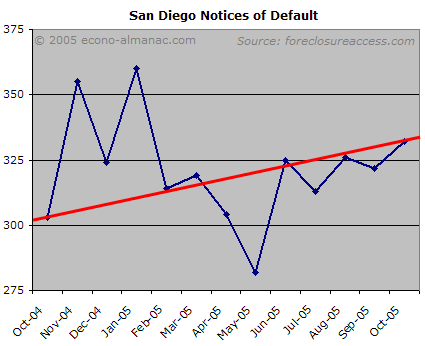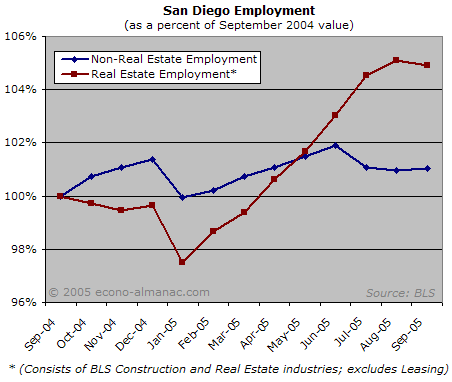The San Diego Union-Tribune today ran an article about the rising rate of mortgage defaults in San Diego. It’s a good article, but—brace yourself for words you never thought you’d read on this website—their interpretation of the data is more negative than my own.
Wow, my fingers almost seized up just typing that.
Those who have been reading the site since last year know that I used to continually assail the Union-Tribune for their blatant housing market boosterism. Starting in early 2005, though, the paper started to adopt a much more balanced viewpoint, and since then they’ve done a pretty good job of covering the real estate scene.
Given my openly bearish long-term view on housing, however, I never thought they’d actually interpret a data point more pessimistically than I would. But that’s exactly what they’ve gone ahead and done, if only to a small degree, and it really underscores how much popular perception of this market continues to change.
The statistic in question is as follows: mortgage defaults in the third quarter of 2005 were up 39.5% year-over-year.
That sounds a little scary, but consider the raw numbers: Q3 2004 saw 649 defaults, whereas this past quarter saw 906. A large jump percentage-wise, to be sure, but a tiny, tiny number overall. To put it in perspective, there are over a million housing units in San Diego. That means that fewer than one out of every thousand San Diego real estate owners default each quarter—hardly an alarming figure!
What does the big 39.5% jump mean? Nothing, really… it simply means that defaults in 2004 were insanely low. Any homeowner who had financial trouble in 2004 was almost guaranteed to have some home equity ready to bail him or her out. You had to be a complete fiscal trainwreck to get to the point where you were actually defaulting on your mortgage.
In 2005, after a year of price flatness, there are more homeowners without an equity cushion to help out in emergencies. So it is natural that defaults would rise. But at this point the rate of change is much less important than the overall amount of defaults, and that amount is absolutely nothing to worry about.
Of course, the UT is quick to make this point as well, but the fact that they even considered the rise in defaults as worthy of its own story indicates that they are a little more worried about this particular stat than I am.
Here, incidentally, is a chart showing the number of defaults, with a trend line to indicate the relatively gentle year-over-year rise.

Based on reasoning I’ve outlined elsewhere, I expect defaults to rise very significantly over the next couple of years. I think we could easily see default rates at 5 to 10 times their current levels. But there’s nothing to worry about just yet.
Employment
Nothing too terribly alarming is happening in the employment department, either.

Admittedly, for the first time this year employment in the real estate sector declined. However, this is a typical seasonal pattern for the fall and winter months, and as such is nothing to be alarmed about. Real estate employment is still up 5% since this time last year, as opposed to the anemic 1% annual growth in non-real estate jobs.
Someday that red line will really take a dive as people realize that flipping homes back and forth doesn’t actually create wealth. For now, though, the real estate sector is still flying pretty high, and the overall San Diego economy continues to act well.
Conclusion
What can I say? It’s the same old story every month with this report. Things seem fine on the surface, but the imbalanced and entirely housing-dependent nature of our economy becomes ever more clear. Things haven’t headed downhill yet, but when they do, that’s when the housing market will really start to suffer.
